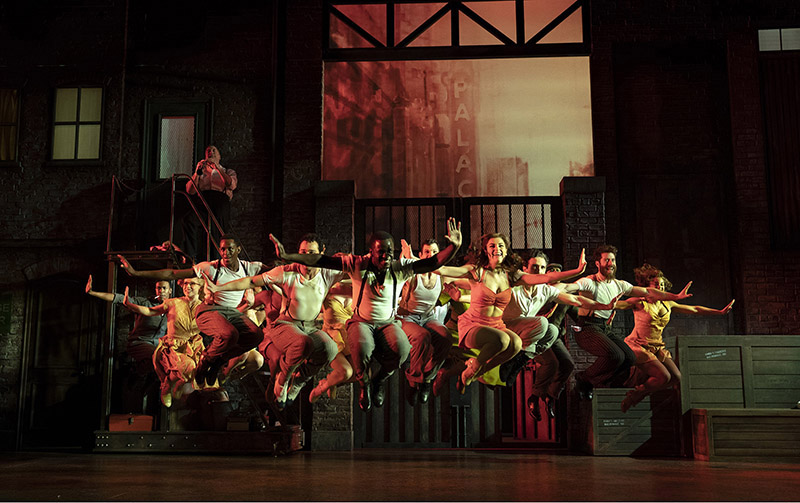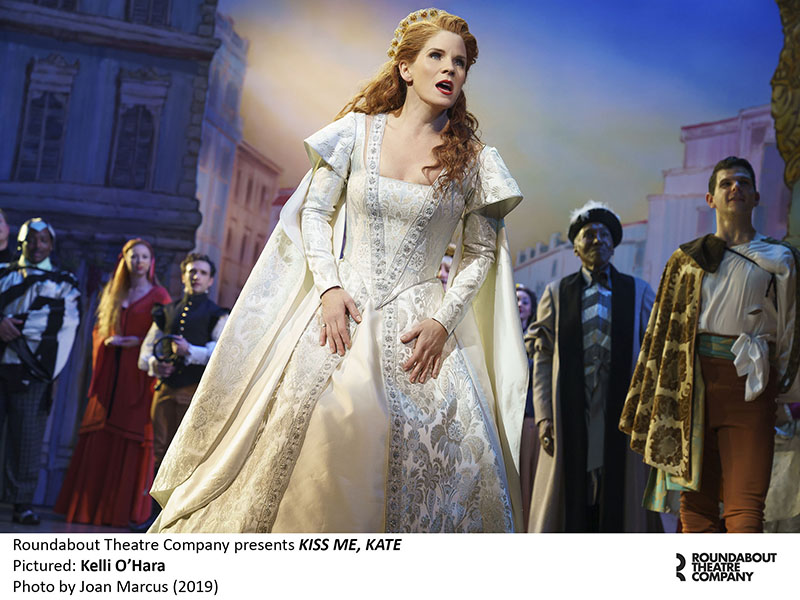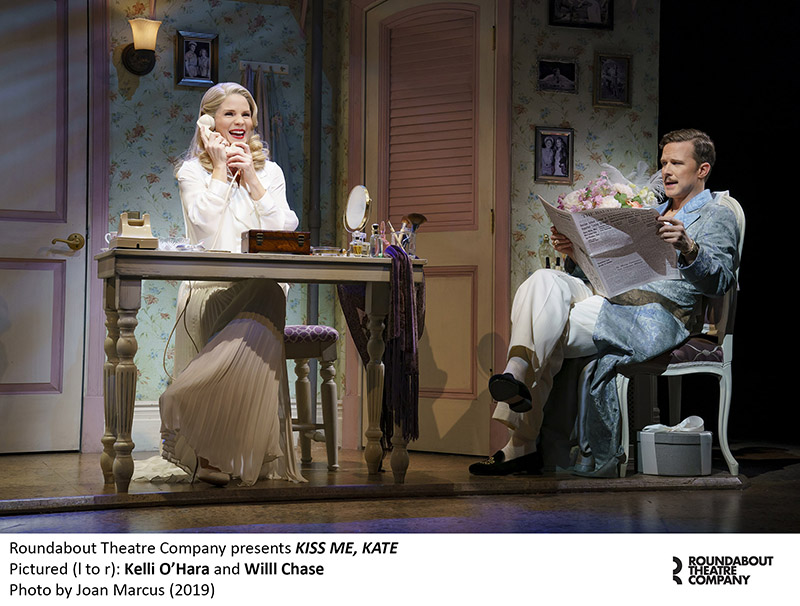
Last year, scenic designer David Rockwell tackled the late ‘80s look of the upbeat musical Pretty Woman. And while this year he has also tackled another iconic ‘80s tale (Tootsie), he is also jumping back in time to the 1940s with the classic Broadway musical Kiss Me, Kate. The shows co-stars Broadway icon Kelli O’Hara and Will Chase, and the producers were so confident in their cast and crew that they skipped the now-traditional out-of-town tryout and immediately opened on the Great White Way at the famed Studio 54.
Kiss Me, Kate certainly has a strong history on Broadway. Written by Samuel and Bella Spewack, with music and lyrics by Cole Porter, the show first debuted in 1948, and the next year it won the first Tony Award for Best Musical. It has played in the West End of London at least three times, and it was revived on Broadway 20 years ago.

A Show Within a Show
The comedic show is a musical within a musical, as womanizing and narcissistic director/producer/star Fred Graham (played by Will Chase) tries to win back his incensed ex-wife and co-star Lilli Vanessi (O’Hara). To make things worse, they are appearing in his musical rendition of Shakespeare’s The Taming of the Shrew, whose subject matter does not lend itself to an amiable onstage energy to counteract the backstage anger. Another behind-the-scenes romance in the show involves an actress and her gambling beau who is in hot water with gangsters. Naturally, a romantic farce of the mid-20th century needs some finessing in the 21st century, so writer Amanda Green came on to make the appropriate tweaks and imbue it with a better gender dynamic.
This latest incarnation of Kiss Me, Kate has the look of a classic Broadway show with modern touches, and Rockwell looked to the past for inspiration. “Very early on in the design process, it was decided to set the show in the period in which it was originally written: the late 1940’s,” he explains. “It was at that point that we began to explore various types of flat, painted scenery, experimenting with numerous styles from the very abstract to more naturalistic. In the end, a very loose, sketch-inspired style was chosen. It captured the feeling of traditional painted scenery and yet also had what might have been considered a modern edge at that time.”

Elaborate Collaborations
Director Scott Ellis and Rockwell have collaborated before on shows including She Loves Me, On The Twentieth Century, and You Can’t Take It With You, all of which involved intricate staging, not to mention lighting and choreography challenges centered around the impressive structures that they erected. With Kiss Me, Kate, Rockwell recalls that Ellis was taken with a particular research image that they found. “It was a very abstract, dreamlike rendering of a backstage area with many levels and web-like fly lines,” says the designer. “It ended up informing the set pieces for the opening number as well as the main backstage setting itself,” which is three stories high. “Scott and I thought using elevations for staging would be powerful.”
Rockwell had no problem dealing with with Kate’s show-within-a-show aspect. The Tony Award-winning scenic designer relishes the chance to expand his palette on any given project. “I happened to have designed two, what you might call ‘backstage musicals,’ this season, including Tootsie,” he says. “Both of them contain shows within themselves. It becomes a kind of meta exercise, because you have to manufacture a layer of artifice on top of the artifice posing as reality.”
Despite the “musical within a musical” approach to both Kiss Me, Kate and Tootsie, the two shows required a different approach. “The main difference was that Kiss Me, Kate had four separate and distinct locations, which took up a good deal of fly space,” explains Rockwell. “On the other hand, Tootsie, while it had only had one show within a show location, it had to transform a vista from a backstage view to an audience view, which was a completely different problem.”
From the start of the design process to the first preview, Rockwell spent 10 months working on the show. Scenic Art Studios in Newburgh, NY painted all of the backdrops. Dan Brown was the production prop master for the show. Working closely with Rockwell and company, Brown “procured, engineered and built all of the props used in the show,” says Rockwell.

Nine Set Pieces
There are nine set pieces in total, five of them a part of The Taming of the Shrew that look more old-school. One even has a small, two-story structure at stage left. The four main, more intricate set pieces are mostly in the behind-the-scenes world of the show and take up different amounts of space on stage. There is the three-level “backstage corridor” area, the alley behind the theater that includes a gate and painted drop behind it, and the dressing rooms for the actors, plus one of the Shrew sets that includes a market square at stage right and two-story structure at stage left. Finding space to store everything was certainly tricky.
“The wing space at Studio 54 is very limited, although the depth is adequate enough,” remarks Rockwell. “Early on, it was decided to dedicate the wing space for the two star dressing rooms, which appear multiple times throughout the show, as well as for the storage of the main backstage set, which appears quite often as well. The old-fashioned style in which the musical itself was written — with its ‘in-one’ numbers played far downstage in front of a drop — became a giant boon for pulling off the transitions.” He adds that it was helpful that he had prior experience working in Studio 54 for She Loves Me, “another production with significant scenic demands.”
The aforementioned dressing rooms are smaller pieces that slide onto the front of the stage from opposite sides of the stage. They are connected by a single door and allow the two quarreling stars to prance back and forth during heated arguments. “By putting the dressing rooms on thin low-profile pallets, rather than castered wagons, the actors are able to step off onto the stage floor as if it is all part of the same room,” explains Rockwell. “It’s much less confining and gives a greater sense of spacial continuity.”
The Main Backstage Set
Rockwell states that the main backstage set was the most challenging one to create. “What was particularly complicated was designing its storage and movement,” he says, “as well as the egress for the actors on and off the unit once they have exited into the various dressing rooms on the different levels.” There is a lot of dynamic motion achieved by the cast on this structure, with the actors moving up, down, and one even jumping off the second level. It commands the audience’s attention (and makes for an interesting contrast to director Matthew Warchus’ 2008 revival of Boeing-Boeing, which had characters often racing in and out of five onstage doors placed in a semi-circular set).
Splitting up the Shrew backstage area into the real Studio 54 backstage was also a challenge. “The backstage set traveled in tracks up and downstage,” explains Rockwell. “It never left the tracks, but it was built to unfold to a flattened footprint for storage upstage.”
Naturally, Rockwell’s grand sets made things a bit tricky for lighting designer Don Holder, who won a Tony Award for another Kelli O’Hara vehicle, the 2008 revival of South Pacific. The veteran LD did not have as many overhead grid positions as he might normally utilize. “The show within a show calls for four separate locations, so lighting positions were quite minimal,” says Rockwell. “To light each scene well was quite tricky and quite an achievement in the end.”
“David maintained an active presence throughout the tech process,” Holder tells PLSN. “He communicated his intentions quite clearly, and I did whatever I could to assist in realizing them. As an example, David expressed an interest in specifically accenting many of the architectural details (escutcheons) on the show’s ‘False Proscenium’ and other Elizabethan facades. We added many lights during the course of tech rehearsals and previews to accomplish this objective.”
“One of the biggest challenges was to determine how to use the very limited amount of room available — overhead and in the wings — to properly reveal the nine different locations that David designed for the production,” continues Holder. “Given that we had only three overhead electrics and just a few lighting ladders to carve out the space and to satisfy the rather complex storytelling requirements, we used many automated fixtures with discharge and LED sources. So the challenge included adapting an approach that retained the sense of a warmer tungsten-based palette despite the relatively cold native source. It also required a lot of coordination with the technical and scenic departments to carefully allocate literally every inch of overhead space between scenery and light so it could be used to optimal advantage. All of the the stage pictures in the play-within-the-play were designed using painted muslin borders, legs and backdrops which required several versions of low angle front-light to activate them while simultaneously making them appear smooth, dimensional and layered.”
Holder adds that were many challenging sequences Kiss Me, Kate, none more so than the second Act opener “Too Darn Hot”. He calls it “a spectacular nine-minute dance number that begins with a realistic statement: a lone performer in an alley outside the stage door, listening to the Orioles game on the radio As more and more of the cast and crew spill into the alley during their intermission, the simple scene lit with only a few motivating sources slowly explodes into a highly kinetic and bravura dance performance, the light shifting into abstract expressionism. All of this was staged in the extreme downstage wing of the playing space in front of a realistically rendered ‘Alley Hanger’, so the number of lighting ’tools’ I had to work with was somewhat limited. The combination of the above, plus strategizing a slow but steady crescendo to an ‘incredibly hot’ and athletic finale, was a real challenge, especially when it all had to be accomplished during a two-hour tech session.”
After all their hard work, Rockwell loves how this show turned out. “With both Kiss Me, Kate and Tootsie, I’ve had the pleasure of working with creative teams who really understood how to update elements of an existing story for today’s audiences without compromising any joy or humor in the process,” he says. Working on this musical added another pleasure for him. “It was a chance to fall in love with the incredible score, and I learned once again how much I love working in Studio 54 with the Roundabout family.”


